Modern Service Industry
Modern Logistics Park Project of Liaoyuan City
1 Introduction to the Project
1.1 Project background
1.1.1 Product introduction
A logistics park refers to a place where multiple logistics facilities and different types of logistics enterprises are concentrated in space in an area where logistics operations are concentrated. It is a gathering point for logistics enterprises with a certain scale and multiple service functions.
According to the service area, logistics parks can be divided into port type logistics parks, airport type logistics parks, and inland type logistics parks.
Figure 1 Classification of Logistics Parks
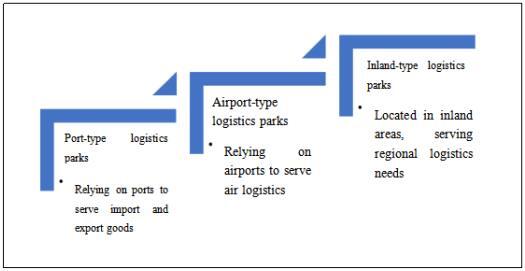
The main functions of logistics parks include transportation, warehousing, distribution, packaging, loading and unloading, circulation and processing, and other logistics activities. These functions improve logistics efficiency and reduce logistics costs through intensive facilities and shared operations. Logistics parks are usually located around cities or transportation hubs, facilitating the connection of various transportation modes such as highways, railways, waterways, etc., thus achieving efficient logistics operations.
The project relies on the location and functional advantages of Lianchang Industrial Park in Liaoyuan New and High-tech Industrial Development Zone to develop logistics and warehousing services, and create an inland modern logistics park.
1.1.2 Market prospect
According to the Seventh National Logistics Park Survey Report released by China Federation of Logistics and Purchasing on August 22, the total number of logistics parks in China is 2769, an increase of 8.5% compared to the 2553 in the sixth survey, maintaining an overall stable growth trend. Moreover, the proportion of logistics parks in operation and under construction has further increased.
Figure 2 Survey on the Number and Growth Rates of Logistics Parks Nationwide from 2006 to 2024
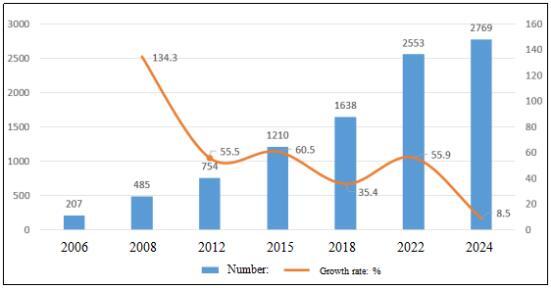
Among the 2769 residential areas included in this survey, 2127 are in operation (with logistics services already carried out in the park), accounting for 76.8%, an increase of 2.2 percentage points from the 74.6% surveyed in 2022; there are 468 companies under construction (parks under construction but not yet operational), accounting for 16.9%, an increase of 1.4 percentage points from the 15.5% surveyed in 2022; there are 174 companies in the planning stage (feasibility studies have been conducted in the park but construction has not yet started), accounting for 6.3%, a decrease of 3.6 percentage points from the 9.9% surveyed in 2022.
Figure 3 Proportions of Logistics Park Construction Status
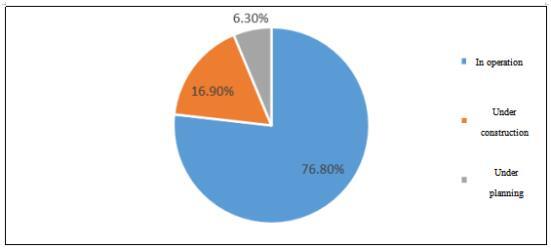
From the perspective of regional distribution, the total number of logistics parks in the eastern, central, and western regions has increased. Among them, the number of logistics parks in the western region increased the most, with a growth rate of 13.7%.
The proportion of logistics parks (hereinafter referred to as “parks in operation”) put into operation in the four major economic regions has increased to varying degrees. Among them, the proportion of operating parks in the central region is 73.7%, the highest increase, which is 4.7 percentage points higher than the 69.0% surveyed in 2022; the proportion of parks in operation in the eastern region is 85.2%, the highest among the four economic regions; the proportion of parks in operation in the western and northeastern regions is 70.0% and 79.5%, respectively, an increase of about 2 percentage points compared to the 2022 survey.
Table 4 Comparison Table of the Quantity and Construction Status of Logistics Parks in the Four Major Economic Regions
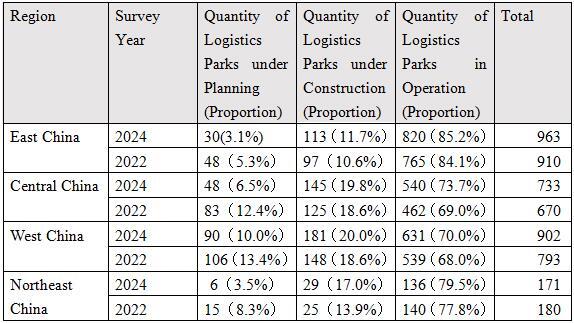
The top three provinces in terms of the total number of logistics parks are Jiangsu, Shandong, and Henan. There are over 100 logistics parks in 12 provinces across the country.
Figure 5 Number of Logistics Parks in Each Province (Autonomous Region, Municipality Directly under the Central Government)
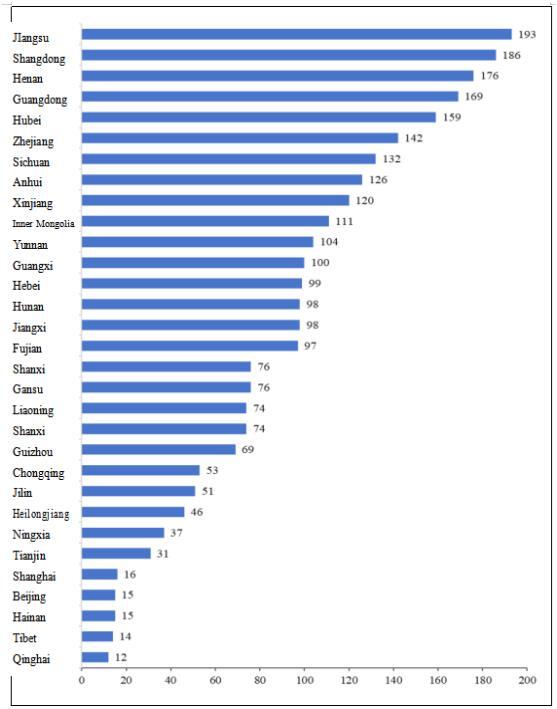
According to the logistics resources and market demand characteristics that the park relies on, and based on the service objects and functions, the parks is divided into five categories: freight service type, production service type, commercial service type, port service type, and comprehensive service type. The survey results show that comprehensive service-oriented parks account for the highest proportion, reaching 63.1%, followed by freight service-oriented parks at 16.0%, commercial service-oriented parks at 13.3%, and production service-oriented and port service-oriented logistics parks at 5.2% and 2.4%, respectively.
Figure 6 Proportions of Different Types of Logistics Parks
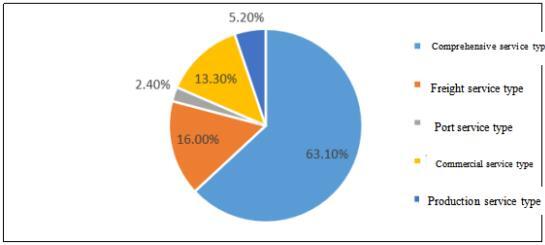
(2) Development trends of logistics parks
① Precision in the service industry. Logistics is the lifeblood of industrial development, and with the acceleration of industrial transformation and upgrading, the logistics industry is increasingly deeply embedded in the industrial chain and supply chain. As a logistics industry cluster, logistics parks are increasingly actively connecting with physical industries, constantly meeting the needs of modern industrial systems for diversified and specialized modern logistics services. For example, Yibin Lingang International Logistics Park in Sichuan Province has built a new commodity vehicle roll on/roll off transportation distribution center in the park to serve the rapidly developing new energy vehicle industry. To serve the development of the non-ferrous metal industry, Jiangsu Hai’an Commercial Logistics Industrial Park has introduced Baijinhui Logistics Co., Ltd. to establish a non-ferrous metal futures delivery warehouse and create a non-ferrous metal trading center. The Shangqiu New and High-tech Zone Pharmaceutical Logistics Base aims to serve the development of the biopharmaceutical industry cluster by creating a channel system for intermodal transportation, including public rail intermodal transportation, public rail sea intermodal transportation, and international railway intermodal transportation.
② High standardization of warehousing. High standard warehouses generally have a net height greater than 9 meters, a floor load capacity exceeding 2.5 tons/m2, and are equipped with unloading platforms and fire sprinkler systems. Compared to traditional warehouses, high standard warehouses can significantly increase the storage capacity of units, and the deployment of automated equipment can shorten sorting time, improve operational efficiency and accuracy, thereby reducing overall costs. According to industry associations’ calculations, high standard warehouses have a space utilization rate 2 to 3 times higher than ordinary warehouses, and a turnover rate of goods 6 to 12 times higher, which highly meets the current requirements of flexible storage and efficient transportation in logistics. At the same time, the explosive growth of the e-commerce industry has driven the rapid development of the express delivery industry, and its demand for timeliness, accuracy, and fire safety has effectively promoted the development of warehousing standardization. At present, there is a structural shortage of high-grade warehouses in China, accounting for only 7.8% of the total area. Even if it reaches the current level of 21.8% in the United States, there is still a gap of about 143 million square meters. Various regions are accelerating the construction of high standard warehouses, among which Suzhou, Langfang, and Guangzhou, which have grown rapidly, added 2.85 million square meters, 1.45 million square meters, and 1.05 million square meters of high standard warehouses, respectively in 2023, an increase of 166%, 92%, and 98% compared to 2022.
③ Networked layout. At present, leading express delivery companies and large supply chain enterprises are accelerating the networked layout of their stations, which objectively requires the establishment of more suitable logistics parks in various regions to attract high-quality enterprises to settle in. In recent years, the number of leading enterprises in logistics park construction and operation entering cities has steadily increased. For example, GLP, as a benchmark enterprise in the construction and operation of global logistics parks, has invested, developed, managed, and operated over 450 logistics parks in more than 70 cities in China.
④ Popularization of the cold chain technology. With the increasing demand for food safety and quality among consumers, as well as the rapid development of industries such as fresh e-commerce, chain catering, central kitchens, and pre-made meals, various regions are accelerating their efforts to seize the cold chain logistics trend, issuing various support policies to encourage the development of cold chain logistics. Professional cold chain logistics parks and high standard cold chain warehousing have developed rapidly. According to industry associations’ predictions, the cold chain logistics market will maintain steady and rapid growth in the next 3 to 5 years, with an average annual compound growth rate of around 20%.
⑤ Functional complexity. The services provided by modern logistics parks have far exceeded the traditional scope of services such as warehousing leasing, cargo transportation, and vehicle parking. They pay more attention to providing value-added services such as information consulting, supply chain management, financial insurance, and live e-commerce according to the needs of settled enterprises, promoting the upgrading of logistics parks from single warehousing and logistics services to modern logistics comprehensive services that integrate logistics, commercial flow, information flow, and capital flow, and creating an industrial comprehensive service platform. For example, Tianjin Airport Logistics Express Park is divided into six functional areas: logistics distribution, warehousing services, value-added processing, exhibition and sales, supporting services, and business offices. It provides diversified services for settled enterprises and greatly enhances the competitiveness of the logistics park in attracting investment. For example, Yiwu Highway Port integrates some functions such as less than truckload express delivery, warehousing and distribution, cargo transfer, intelligent parking, catering and accommodation, information and financial services, auto repair and auto parts, etc. It not only has a comprehensive administrative service hall, but also is equipped with a ground floor commercial street, high-end apartments, office buildings, etc., allowing enterprises to move in with their bags.
⑥ Green and low-carbon. In the context of global “carbon peak and carbon neutralization”, enterprises have begun to attach importance to energy conservation, green and zero carbon in the production and transportation of goods, and pay special attention to the ESG management level of logistics parks (ESG is an index that evaluates the contribution of enterprises in promoting sustainable economic development and fulfilling social responsibilities from three dimensions: environment, society and corporate governance). Therefore, zero carbon logistics parks will become an important development direction for future logistics parks. The most important aspect of ESG management is to achieve green energy substitution and low-carbon transportation within the park. In terms of green energy substitution, due to the large, flat, and unobstructed roof area of logistics park warehouses, the photovoltaic system has high power generation efficiency. The generated green electricity can be used for office lighting in the park, as well as for charging new energy electric vehicles, achieving green electricity substitution in the park. In terms of low-carbon transportation, electric trucks, hydrogen fuel cell trucks, and electric forklifts are used in logistics parks, and new energy charging stations and gas stations are set up to achieve low-carbon emissions for park vehicles. For example, JD “Asia No.1” Xi’an Intelligent Industrial Park, China’s first “zero carbon” logistics park fully meets the park’s electricity demand through the “self-use and surplus electricity grid connection” of photovoltaic power generation , and reduces carbon emissions through the use of new energy operation vehicles and accelerated packaging green reduction, achieving “net zero” carbon dioxide emissions in logistics parks.
From the perspective of supply and demand, the logistics real estate market is currently in a state of supply and demand imbalance, especially in first tier cities where the mismatch between supply and demand is even more severe. Due to the reduction of storage land supply in first and second tier cities, and with China’s further expansion of domestic demand and consumption upgrading, the focus of future logistics real estate competition will be on acquiring land in first tier and hub cities, and gradually extending to second and third tier cities and even county-level cities.
In summary, the project relies on the location and functional advantages of Liaoyuan Lianchang Industrial Park to develop logistics and warehousing services, create a modern logistics park, and have a broad market prospect.
1.1.3 Advantageous conditions of project construction
(1) Policy conditions
In 2021, the National Development and Reform Commission released the Implementation Plan for the Construction of National Logistics Hub Network (2021-2025), which will steadily promote the layout and construction of about 120 national logistics hubs, support the joint construction, sharing, and integration of national logistics hubs within urban agglomerations.
The 14th Five-Year Plan for the Development of Modern Logistics (GBF [2022] No. 17) requires strengthening the connection and coordinated development between industrial parks, industrial clusters, national logistics hubs, logistics parks, logistics centers and other facility layouts.
The Ministry of Natural Resources has issued a notice on strengthening the guarantee of natural resource elements and promoting the high-quality development of modern logistics, which clarifies 10 policy measures from four aspects: increasing the supply of logistics development space, strengthening the guarantee of natural resource elements, promoting the improvement of logistics land quality and efficiency, and enhancing the efficiency of factor support services, in order to reduce the logistics costs of the whole society and promote the high-quality development of modern logistics.
In 2020, the Office of the People’s Government of Liaoyuan City issued the Implementation Measures for Flexible Transfer of Industrial Land in Liaoyuan City (Trial), which proposed that the supply of industrial land through flexible term, first lease and then transfer, combination of lease and transfer, and long-term leasing should be provided through bidding, auction, and listing in accordance with the law; the flexible transfer period for industrial land is generally 10, 20, 30, or 40 years. Allow enterprises to voluntarily choose the land use right transfer period during this period. The Implementation Measures has improved the land supply system in Liaoyuan City while reducing the cost of industrial land.
(2) Industrial advantages
In recent years, Liaoyuan New and High-tech Zone has accurately planned and positioned itself, forming a functional layout of “dual-core drive, one zone and four parks”, and expanding the “4+1 industry” in a large-scale and clustered manner, with 2111 settled enterprises. The textile sock industry is unique. Supporting the reputation of “China’s Cotton Sock Capital” and “China’s Sock Industry Famous City”, with the highest production and sales volume of cotton socks in the country, it has successively become a national-level demonstration zone for the quality and safety of exported sock products and a national-level base for foreign trade transformation and upgrading; the high-precision aluminum extrusion technology is world leading. Led by Qixing Aluminum Co., Ltd., Jusheng Light Alloy Co., Ltd., and Liyuan Refining Co., Ltd., it has built a high-precision aluminum processing base in the north. The high-speed train body profiles account for nearly 60% of the domestic market share, and the lightweight products have entered the high-end market. They have become important strategic partners with Fortune 500 companies such as CRRC, Siemens, Alstom, and Bombardier; the industrial advantages of medicine and health are obvious. It has 176 drug codes and are currently constructing a pharmaceutical fine chemical park covering an area of 2.62 square kilometers. Under the leadership of several key enterprises such as Boda Pharmaceutical Co., Ltd., Boda Weiye, Baikang Pharmaceutical Co., Ltd., and Yinying Pharmaceutical Co., Ltd., the research and development system for anti-tumor, antiviral, and health products has become increasingly mature, becoming the largest chemical raw material production base in Jilin Province; the scale of the supporting industry for new energy vehicles is rapidly expanding. It plans to build a 4 square kilometer new energy vehicle supporting industry base, forming a new energy vehicle supporting industry system with Hongtu Lithium Battery Diaphragm Co., Ltd., Zhongju New Energy Co., Ltd., Junsheng Electronics Co., Ltd., Shengyuan New Materials Co., Ltd., and Jincheng Heavy Industry Co., Ltd. as the core. It has been designated as a strategic partner of FAW by the provincial government and signed a strategic cooperation agreement with FAW Fudi. The modern service industry promotes the integration of the industry and the city. It vigorously develops productive and lifestyle service industries and actively promotes the construction of some projects such as JD.com and Yunxiang Smart Logistics Industrial Park.
(3) Resource advantages
In recent years, Liaoyuan City has continuously optimized and adjusted its energy structure, fully launched the construction of a clean energy heating demonstration city in the north, and carried out 47 clean heating renovation projects such as “coal to gas” and “coal to electricity”, which are expected to reduce coal consumption equivalent to 510000 tons of standard coal. In addition, Liaoyuan City has abundant resources such as wind energy, solar energy, and biomass energy, which provide support for the construction of green and low-carbon logistics parks.
Liaoyuan New and High-tech Industrial Development Zone has formed four characteristic industries: textile and sock industry, world leading high-precision aluminum processing, obvious advantages in medicine and health, and increasingly large-scale new energy. Through centralized management and large-scale operation, the project can achieve logistics resource sharing, improve logistics efficiency, and reduce logistics costs.
(3) Talent advantages
Liaoyuan City has abundant human resources, and there are vocational colleges in the urban area that can train talents according to the needs of enterprises. Liaoyuan City has a good industrial development foundation and is only 115.13 kilometers away from Changchun, the nationally renowned “University City” and “Automobile City”, which can meet the various talent needs of enterprises.
(4) Location and transportation advantages
Liaoyuan has obvious location advantages, located 140 kilometers north of Changchun Longjia International Airport and 240 kilometers south of Shenyang Taoxian International Airport. It is situated on an important axis of Changchun’s one hour economic circle and the Shenyang-Tieling urban agglomeration. Within a radius of 200 kilometers, there are 2 provincial capitals and 8 prefecture level cities, with a population of nearly 40 million. The urban area has built a transportation network of “three rings, four vertical roads, and six horizontal roads”. Regional highway and railway transportation is well-developed, with No. 303 National Highway and Siping-Meihekou Railway running through the entire area. The Liaoyuan-Xifeng and Liaoyuan-Changchun railways, as well as the Changchun-Liaoyuan, Yingkou-Meihekou, Jilin-Caoshi, Liaoyuan-Xifeng expressways and the upcoming Liaoyuan Civil Airport, form a comprehensive transportation system for entering the hinterland of Northeast China and going to sea.
This construction site of the project is located in Lianchang Industrial Park, Liaoyuan New and High-tech Industrial Development Zone, with a superior geographical location. It is 4 kilometers away from the city’s railway station and passenger station, with a 10 minute drive. The park faces No. 303 National Highway, with significant transportation advantages.
1.2 Contents and scale of project construction
The project covers an area of 248700 square meters with a building area of 85000 square meters, mainly constructing an order processing center, a warehousing center, a distribution service center, a financial center, etc.
1.3 Total investment of the project and capital raising
1.3.1 Total investment of the project
The total investment of the project is 650 million yuan, including the construction investment of 520 million yuan and current funds of 130 million yuan.

1.3.2 Capital raising
Self-raising by the enterprise
1.4 Financial analysis and social evaluation
1.4.1 Main financial indexes
After the project reaches the production capacity, its annual sales revenue will be 430 million yuan, its profit will be 87 million yuan, its investment payback period will be 9.5 years (after the tax, including the construction period of 2 years) and its return on investment will be 13.4%.
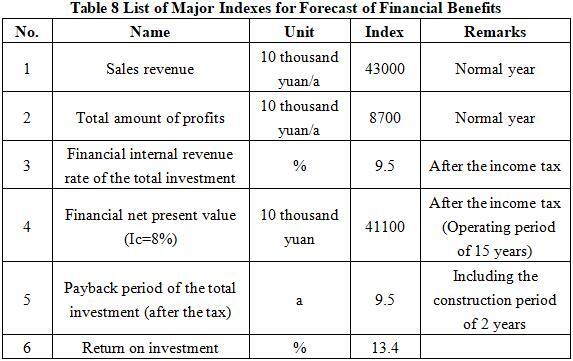
Note: “10 thousand yuan” in the table is in RMB.
1.4.2 Social evaluation
After the completion of the project, it can help the development of upstream and downstream enterprises in the relevant industrial chain of Liaoyuan City, absorb a large number of labor force, and provide employment opportunities; at the same time, it can provide convenient and efficient logistics services for enterprises, further reducing logistics costs.
1.5 Cooperative way
Joint venture or cooperation, other methods can be discussed face-to-face.
1.6 What to be invested by the foreign party
Funds, and other methods can be discussed face-to-face.
1.7 Construction site of the project
Jilin Liaoyuan New and High-tech Industrial Development Zone
1.8 Progress of the project
The civil engineering of the project has been completed.
2. Introduction to the Partner
2.1 Basic information
Name: Management Committee of Jilin Liaoyuan New and High-tech Industrial Development Zone
Address: 1633 Caifu Road, Liaoyuan City
2.2 Overview
Liaoyuan High tech Industrial Development Zone was established in 2001. In 2019, it was approved by the People’s Government of Jilin Province to be established as a provincial-level high-tech industrial development zone, with a planned area of 16.22 square kilometers and a total population of 29000. Located on the axis of the two major economic zones of Changchun and Shenyang, it is 100 kilometers north of Changchun, 200 kilometers south of Shenyang, and 500 kilometers away from Dalian Port. No. 303 National Highway and the Siping-Meihekou, Liaoyuan-Xifeng, and Liaoyuan-Changchun railways run through the entire area, forming a comprehensive transportation system that extends in all directions with the Changchun-Liaoyuan, Yitong-Kaiyuan, Yingkou-Meihekou, and Jilin-Caoshi expressways. As the core of Jilin Province’s southward opening gateway, it plays an important role in the construction of the central innovation and transformation core area of the province.
As the core of technological innovation, the engine of industrial upgrading, the window for attracting investment, and the leader of economic development, Liaoyuan New and High-tech Zone actively cultivates new driving forces for development, takes the path of characteristic development and differentiated development, promotes innovation and entrepreneurship, improves supply quality, and opens up a new model of industrial cluster and chain industry coordinated development. It has been listed as a pilot for regional brand construction of national industrial clusters, a provincial-level demonstration base for mass entrepreneurship and innovation, a national demonstration base for entrepreneurship and innovation of small and micro enterprises, and a demonstration base for new industrialization industries.
2.3 Contact method
Postal code: 136299
Contact person: Song Yang
Tel: +86-437-3292088
Fax: +86-437-3292088
E-mail: jllyjk@163.com
Contact method of the city (prefecture) where the project is located:
Contact unit: Liaoyuan Bureau of Commerce
Contact person: Ai Jing
Tel: +86-18643787709
E-mail: lyjhjxmc@163.com


